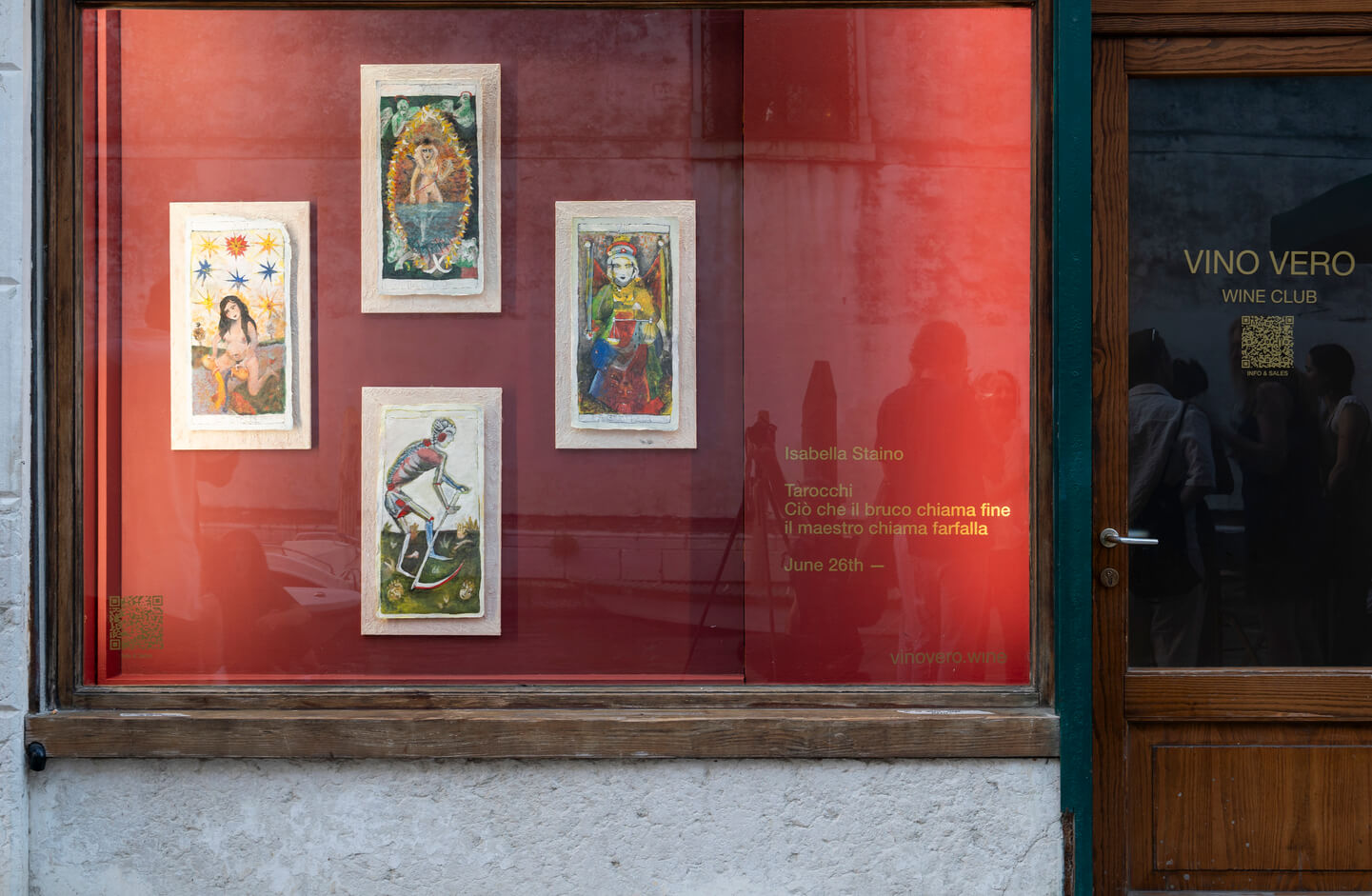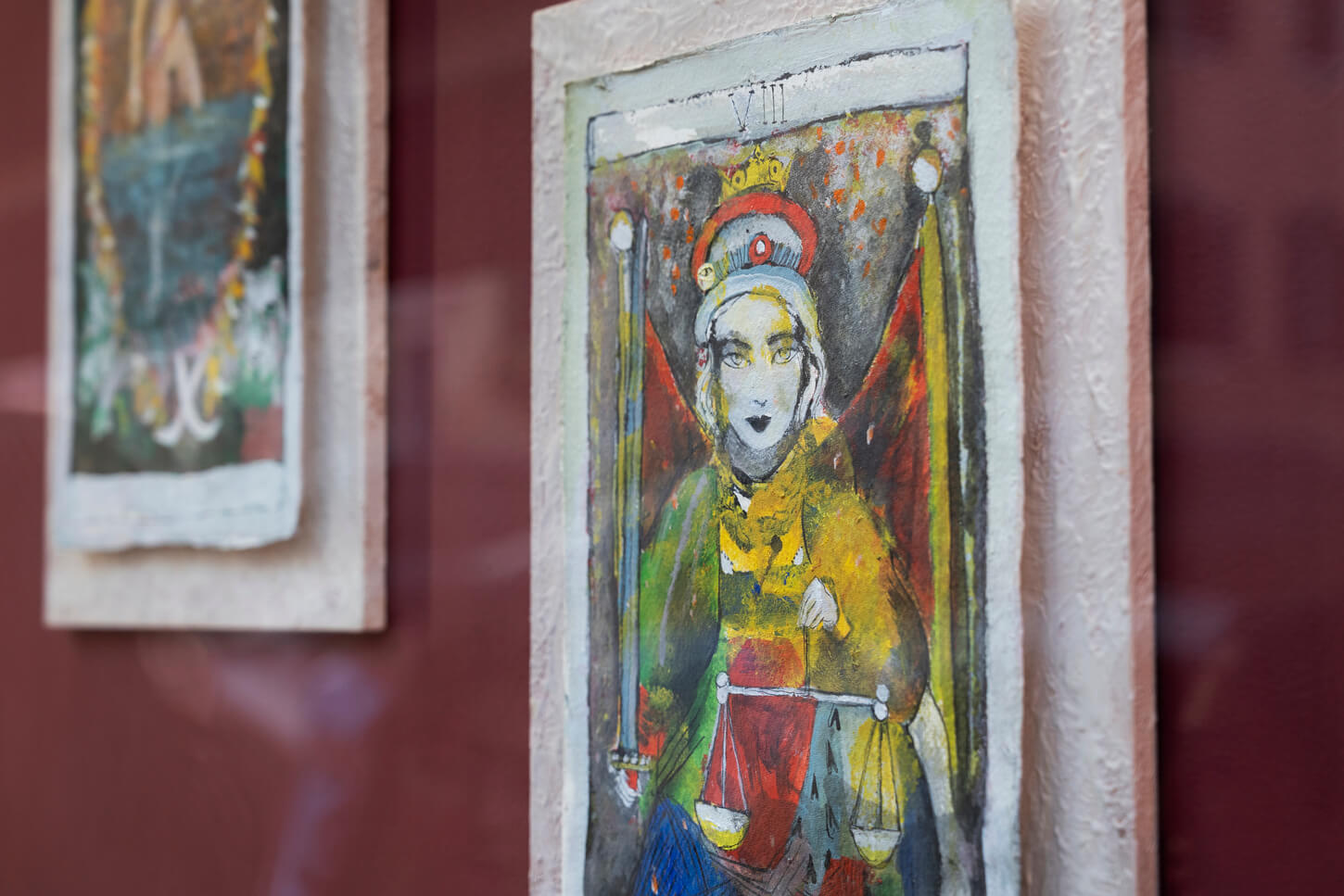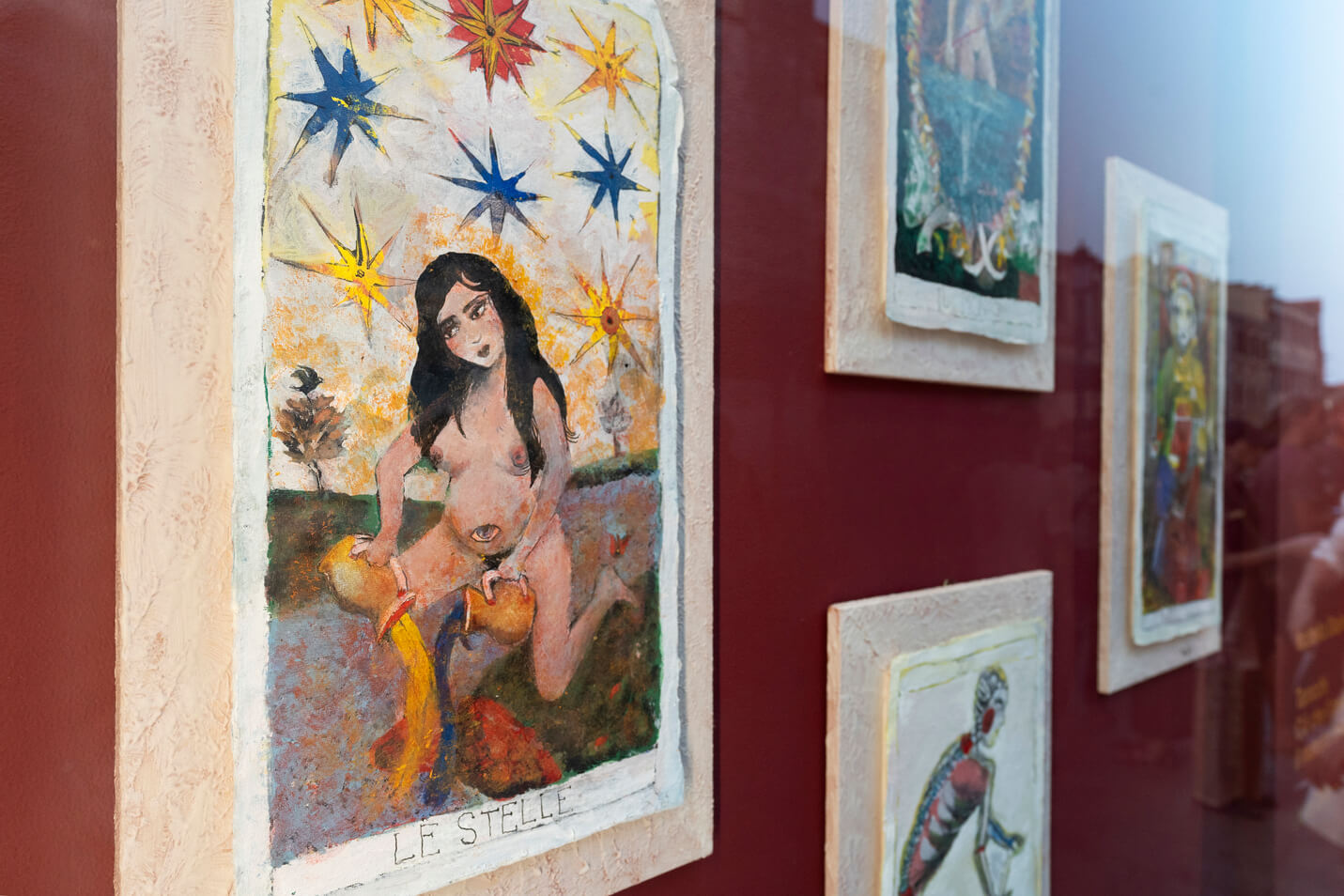Seeing Beyond the Visible. Isabella Staino and the Tarot as an Inner Mirror
Isabella Staino
In the heart of Venice, through the transparent glass of Vino Vero’s window, artist Isabella Staino has created a small secular altar dedicated to inner vision. For the Vetrina Project, she chose to work with the tarot, allowing herself to be guided by a personal reading that became both a narrative engine and a symbolic device.
This is neither illustration nor decoration: her painted figures, born from a body that struggles to see but feels intensely, convey the power of an archaic language that today speaks to us with renewed urgency. In this series, painting is not just a form of expression, but also a tool for listening and interpretation – much like Alejandro Jodorowsky described the tarot as “a poetic machine” capable of awakening dormant awareness.
Staino’s work moves between the visible and the invisible, between boundaries and excess, intertwining personal experience – including that of a wounded body – with a deep exploration of line, color, and above all, the possibility of entrusting art with a ritualistic, transformative function.

MS – Your latest series stems from a work on the tarot, and in particular from a personal reading. What led you to explore this universe, and what role does the tarot play for you today?
IS – This painting project had a very long gestation. I had already done something similar when I was young, having painted the 22 Major Arcana using the technique I worked with at the time. So it’s really been decades that I’ve wanted to return to this subject.
The spark came from a friend, Emiliano, who helped me understand which cards I should represent. And since I can’t read on my own due to my visual impairment, he also read to me Jodorowsky’s book on the tarot – specifically the ancient Marseille tarot, which Jodorowsky reinterpreted with his own color palette.
With that book by our side, we began the card reading. The first four cards were Death – the nameless card – then the Star, Justice, and the World. I started painting them, chose a format, and from there the project took shape. Now I’m continuing it, card by card, until I complete all 22.
MS – Alejandro Jodorowsky described the tarot as “an alphabet of the unconscious”, a mirror reflecting our inner world through archetypal images. In your work, there seems to be a dialogue between this symbolic dimension and your painterly gaze: what did you find in the tarot that spoke to you so directly?
IS – Let’s say the language of the tarot, especially as Jodorowsky explains it, feels like it was made for my painting. Everything I read about tarot reading – or about card reading in general, where there’s a specific iconography – aligns perfectly with my work. It’s a language with very ancient roots – I would even say lost in time. But through my hand, it gets reinterpreted and brought into the present.
In everything I paint, I feel this journey. Even in works where the connection is less obvious, or where you can’t quite tell where the inspiration comes from. For example, I draw a lot from dreams – and that, too, clearly speaks to the tarot and to Jodorowsky. A dream is just that: a kind of elaboration, or something that comes from far away, something indefinable – and sometimes a piece of it falls onto the canvas.

MS – Your painting method is deeply influenced by a particular visual condition. Can you tell us how the progressive loss of sight has transformed your way of painting? How do limitation and freedom intertwine in your work?
IS – My visual impairment has definitely influenced the way I paint, even though I can’t quite tell how. Let me explain: everything makes its way into the painting, everything passes through – and sometimes I don’t know how it got in, or where it came from, and I can’t even always recognise it in the final work. I don’t know what entered or from where.
So yes, my eyesight has technically affected my process: I paint using video magnifiers, and my painting time has gradually shortened because my eyes tire more easily. However, in recent years, the level of detail in my work has actually increased rather than decreased. When you look at the paintings, you’d never guess there’s been a loss of vision.
The magnifiers allow me to work in extreme detail, and maybe that’s why my work has moved toward this more meticulous dimension – though that’s just a theory. Fortunately, painting is much broader than that, and as I said, it can come from far away. My eyes are just the final step in that process.
MS – Your artistic journey has gone through different phases and languages, but there seems to be a deep coherence in the way you seek to give form to the invisible. What do you see as the key milestones in your artistic research?
IS – I started painting as a child, so by now my life in painting has become truly long and I’ve naturally gone through different phases. I studied at the Academy of Fine Arts in Florence, where I attended Professor Giulietti’s school, focusing on abstractism. Though, to be honest, there’s always been some recognisable form in my work. Still, that abstract foundation often lies beneath my paintings, especially the larger canvases, because I usually start with patches of color moving across the surface – even just for fun, which is an important part of my process.
If I had to identify a common thread in my painting journey, I’d say it’s the desire to open windows. Since paintings are physical objects that hang on walls, I like to think of them as windows — as something you can look through, offering a glimpse into something else, something that can only be seen through that frame. But behind it, there’s a much larger world.
Sometimes I’ve called it a “complete world”. In other painting cycles, I’ve used the term “views toward elsewhere”, because the figures in the paintings often look at something unseen – something we can’t quite identify, but can imagine. And for me, just the possibility of imagining it – and making others imagine it – is a way to expand the painting, to think of it as a whole world with its own balance.
My paintings are definitely places I’d love to live in – and that’s something I find throughout all my work. I love the environments and atmospheres I paint, and yes, sometimes I wish I could take a step and walk right into them.

MS – Coming back to the Venetian project: did the “reading” from which you drew your images also have a divinatory, interpretive function for you? The work seems to move between interpretation and revelation, and your painterly gesture appears to have contributed not only to representing but also to understanding the messages of the cards. Was that the case?
IS – The card reading came out of a very pleasant moment shared with a friend, where we read what Jodorowsky wrote about each card and added our own reflections, both on the individual cards and on the meaning of the four that came up together.
Then came the studio work, which was quite challenging, because I wanted the painting to carry not only the symbolic content of the cards, but also the lived experience of that day of the reading. For instance, the Justice card came out reversed – and I chose to reflect that in the painting by creating a double visual reading: the card can be viewed from both orientations, thanks to a mirrored head in the lower part, reminiscent of playing cards or certain traditional iconographies. I tried to stay true to the elements that Jodorowsky highlights as essential – like specific colors or forms – while also honouring what happened that day during the reading with my friend. And then I left space for my own interpretation. It felt a bit like working within a kind of framework, where some elements needed to remain fixed, yet I still had the freedom to interpret each card through my painting, just as I would with any other work.
MS – Finally, what projects are you currently working on? What do you envision as the next step in your journey?
IS – Right now, in addition to the exhibition in Venice, I have a major show in Peccioli, in the province of Pisa, where 46 of my paintings are on display. It’s a large exhibition that will run until the end of September. I also have another show on Elba Island, in Rio Marina, where I presented a project called The Queen of the Sea Urchins, entirely dedicated to sea urchins.
So at the moment, I’m very focused on exhibitions and shows. But as soon as I return to the studio, I’ll definitely continue working on the tarot series – there are 22 cards, which is quite a lot – so I plan to do another reading of four new cards soon and start working on those. My hope is to eventually be able to create a complete deck.




